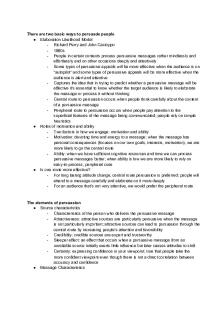Social Psychology Chapter 8 Notes PDF

| Title | Social Psychology Chapter 8 Notes |
|---|---|
| Author | Ella MacCallum |
| Course | Social Psychology |
| Institution | SUNY New Paltz |
| Pages | 2 |
| File Size | 46.2 KB |
| File Type | |
| Total Downloads | 7 |
| Total Views | 159 |
Summary
chapter 8...
Description
There are two basic ways to persuade people ● Elaboration Likelihood Model - Richard Perry and John Cacioppo - 1980s - People in certain contexts process persuasive messages rather mindlessly and effortlessly and on other occasions deeply and attentively - Some types of persuasive appeals will be more effective when the audience is on “autopilot” and some types of persuasive appeals will be more effective when the audience is alert and attentive - Captures the idea that in trying to predict whether a persuasive message will be effective it’s essential to know whether the target audience is likely to elaborate the message or process it without thinking - Central route to persuasion occurs when people think carefully about the content of a persuasive message - Peripheral route to persuasion occurs when people pay attention to the superficial features of the message being communicated; people rely on simple heuristics ● Roles of motivation and ability - Two factors in how we engage: motivation and ability - Motivation: devoting time and energy to a message; when the message has personal consequences (focuses on our own goals, interests, motivation), we are more likely to go the central route - Ability: when we have sufficient cognitive resources and time we can process persuasive messages better; when ability is low we are more likely to rely on easy-to-process, peripheral cues ● Is one route more effective? - For long lasting attitude change, central route persuasion is preferred; people will attend to a message carefully and elaborate on it more deeply - For an audience that’s not very attentive, we would prefer the peripheral route
The elements of persuasion ● Source characteristics - Characteristics of the person who delivers the persuasive message - Attractiveness: attractive sources are particularly persuasive when the message is not particularly important; attractive sources can lead to persuasion through the central route by increasing people’s attention and favorability - Credibility: credible sources are expert and trustworthy - Sleeper effect: an effect that occurs when a persuasive message from an unreliable source initially exerts little influence but later causes attitudes to shift - Certainty: expressing confidence in your viewpoint; true that people take the more confident viewpoint even though there is not a direct correlation between accuracy and confidence ● Message Characteristics
-
●
Message quality: high-quality messages are more persuasive in general, especially for people who are strong in motivation and ability; messages are of higher quality when they appeal to core values of the audience - Vividness: when information is vivid- colorful, interesting, and memorable, it tends to be more effective; vivid but misleading information trumps non-flashy valid information - Identifiable victim effect: people are more inclined to be persuaded to act on behalf of a cause by portrayals of clearly identifiable victims - Fear: it’s advisable to make ad campaigns frightening but to make sure that they include concrete information that supports the frightening cause - Culture: it’s important to tailor a message to fit the norms, values and outlook of the cultural group of your audience Audience Characteristics - Need for Cognition: people differ in their need for cognition, the degree to which they like to think about things; people with a weaker need for cognition don’t find contemplation as fun - Mood: it’s easier to persuade when the audience is in the right mood - Age: younger people are easier to persuade...
Similar Free PDFs

Social psychology chapter 8
- 6 Pages

Psychology Chapter 8 Notes
- 6 Pages

Chapter 13 Social Psychology
- 9 Pages

Chapter 12 Social Psychology
- 5 Pages

Chapter 12 Social Psychology
- 10 Pages

Chapter 12: Social Psychology
- 3 Pages

Social Psychology Classmate Notes
- 48 Pages

Social Psychology Notes
- 30 Pages

Social Psychology EXAM Notes
- 12 Pages

Psychology Chapter 8 homework
- 3 Pages
Popular Institutions
- Tinajero National High School - Annex
- Politeknik Caltex Riau
- Yokohama City University
- SGT University
- University of Al-Qadisiyah
- Divine Word College of Vigan
- Techniek College Rotterdam
- Universidade de Santiago
- Universiti Teknologi MARA Cawangan Johor Kampus Pasir Gudang
- Poltekkes Kemenkes Yogyakarta
- Baguio City National High School
- Colegio san marcos
- preparatoria uno
- Centro de Bachillerato Tecnológico Industrial y de Servicios No. 107
- Dalian Maritime University
- Quang Trung Secondary School
- Colegio Tecnológico en Informática
- Corporación Regional de Educación Superior
- Grupo CEDVA
- Dar Al Uloom University
- Centro de Estudios Preuniversitarios de la Universidad Nacional de Ingeniería
- 上智大学
- Aakash International School, Nuna Majara
- San Felipe Neri Catholic School
- Kang Chiao International School - New Taipei City
- Misamis Occidental National High School
- Institución Educativa Escuela Normal Juan Ladrilleros
- Kolehiyo ng Pantukan
- Batanes State College
- Instituto Continental
- Sekolah Menengah Kejuruan Kesehatan Kaltara (Tarakan)
- Colegio de La Inmaculada Concepcion - Cebu





